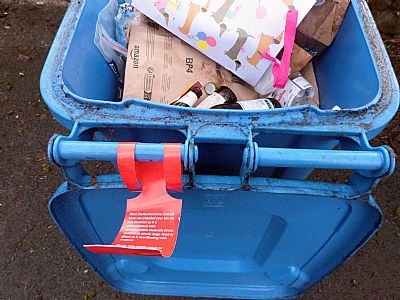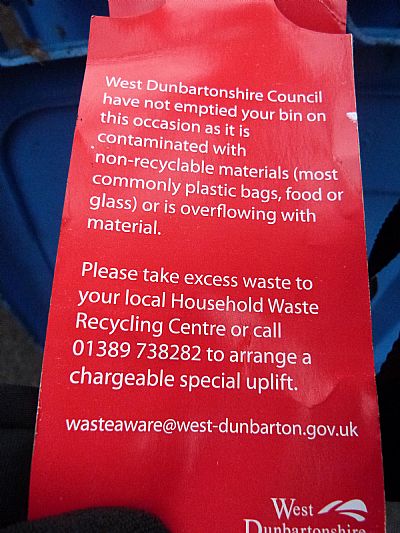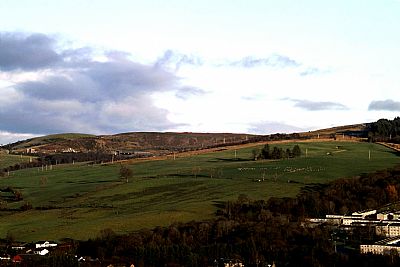LANDFILL & YET MORE RUBBISH
Also see LITTER PICKING : index.asp?pageid=721880
ACCESS : Residents can access the recycling centres at Dalmoak and Erskine Ferry Road from 8:00 am until 7:30 pm almost every day of the year. There are also over 125 recycling points for glass and in some cases other materials and clothes.
///perfumed.quilt.spicy Main landfill site.
///residual.motorist.energy Dalmoak recycling centre.
///emerald.purified.bronzer Erskine Ferry Road recycling centre.
West Dunbartonshire has a major landfill site above the Vale of Leven, the Auchencarroch site. What a rubbish place to explore. This one ceased operating in 2024 with that role being moved elsewhere. A permanent safe capping was laid over it. However local residents continued to report odours from it for some time afterwards.
Don't worry, we are not suggesting you go there, but it is well worth being aware of it. It is but the end point of a sequence of events that we are all part of daily.
There is a tendency to put unwanted items and materials out of sight - out of mind. Too few of us give more than a moment's thought about all that stuff that disappears with the refuse removal men each and every week. Where does it go? What happens to it?
That out of sight - out of mind mentality can go too far. West Dunbartonshire, like so many other local authorities is challenged with the cleaning up by thoughtless louts who chuck stuff out of their car windows or even dump in enormous quantities along our scenic waysides. Removing it adds extra strain to council budgets and that inevitably gets passed back to the community as extra coumcil tax. Many volunteers try to deal with the small items, but large items or pile just have to stay there until something can be done.
Local residents are reasonably good at putting items in their correct bins. And a trip to the local recycle point from time to time is readily accepted. From then on, what happens?


So what happens if you do not comply? The Council will not uplift your refuse if you mix recyclable and non-recyclable materials in the same bin. Yes, you can recycle glass, but it needs to be placed in a glass recycling bin (which are dotted around West Dunbartonshire). The bin at this house had glass bottles in with the other materials and this is not acceptable. Glass bottles, as many other discarded material require specialist process if they are to be recycled.
We in West Dunbartonshire are fortunate to have a fairly efficient disposal system. Many items and materials are recycled; the rest is put to landfill. Fortunately too, that landfill has little impact on our environment, at least visually. Few of us are really even aware of where that happens. Yet much of it is right above the Vale of Leven; a vast area serving a local populace and well beyond.
Above Bonhill are the twin hills of PAPPERT HILL and smaller one at Auchincarroch Farm. Auchincarroch Road runs up from Jameston from where you can get to Gartocharn and even Croftamie. The road runs through some lovely countryside. These two hills are the western edge of Blairquhomrie Muir, roughly speaking, part of Dumbarton Muir. The two hills have a saddle between them and this is the location of a major landfill area. It is also a diverging catchment area; one side having a burn towards Jamestown, the other side flowing roughly north-east and northwards. This is important as it influences the management of the infill and also the leaching from it.
Up there is a recycling centre on the road up and a complex layout of infill and leach water control and settlement dams.
From the Vale though this looks much like any other hill - most of the time. Just sometimes you may notice a pale section of geofabric spread out to stablise the surface before topsoil is applied and the hill turned to something like natural environment. Over the years this is growing. Obviously. The sheer scale is amazing. And it will always grow. Perpetually. Now that is something to think about.
It is very strange how some people prefer to dump great piles of rubbish along our scenic roads and other areas, when there are recycle centres at strategic points that are free to use for the general public. There is one at Dalmoak between Dumbarton and Renton and one at Ferry Road in Old Kilpatrick. By contrast the fines for littering are enormous. The following comes directly from the Scottish Government website on waste :
Penalties for litter and flytipping
There are fixed penalties of £80 for littering and £200 for flytipping (from 1 April 2014). Alleged offenders are required by law to provide their name and address to enforcement officers (from 1 June 2014).
Penalties can be issued by the police, by local authorities, and – since 1 April 2015 – by public bodies including Loch Lomond and the Trossachs National Park.
If the case goes to court, a person who is caught littering will have to pay a fine of up to £2,500. Someone convicted of flytipping could be fined up to £40,000 and/or imprisoned for up to 12 months.

In this picture taken from across the valley, you can see the natural hills on the left and right. The landfill is most of the brown area between them.
Out of sight; out of mind; someone else will probably find.
The reasons that people litter is hard to explain. Some people are naturally messy, while others go to great lengths to remove rubbish from their own properties and dump it somewhere else. So much bulk home, garden and commercial waste is dumped in this way along our roads. Some people just don't think about how a single item can join others and become an enormous problem.
If you drop a single item into a watercourse, where does it go once it is out of your sight? Much re-emerges just a bit further downstream. And much goes somewhere else. So much floats. So much effects wildlife including fish. So much damages the shores of other parts of Scotland. Consider the beach at Arrochar.
The beach at Arrochar is within an extremely beautiful valley at the head of Loch Long. Why is that beach always so dirty? it may be because of rubbish dropped or washed into our own local watercourses. That beautiful setting has the misfortune of acting as a Tidal Litter Sink. A result of the beautiful setting also being in a geological form that disproportionately receives more floating debris than most sea lochs.
The litter on Arrochar foreshore comes about equally from the Irish Sea and the Clyde River • Both of these deliver about 62,000 items of litter onto the foreshore, mixed with seaweed, each year • Arrochar foreshore receives about 11% of all the marine litter entering the Clyde, whether from the Irish Sea or the river • About 1.2 tonnes of marine litter ends up on Arrochar foreshore from the Irish Sea and Clyde catchment combined. [‘Marine Scotland. Crown Copyright’]. Is that your rubbish all the way from West Dunbartonshire, perhaps dropped near a drain or natural watercourse?
MARINE SCOTLAND : THE ARROCHAR ‘LITTER SINK’. TOPIC SHEET NUMBER 98 V1https://thelochsidepress.com/wp-content/uploads/2019/06/Turrell2018-ArrocharLitterSink.pdf
SCOTTISH ENVIRONMENT PROTECTION AGENCY (SEPA) : https://www.sepa.org.uk/environment/waste/waste-data/waste-data-reporting/waste-site-information/
SCOTTISH GOVERNMENT website on waste management : https://www.gov.scot/policies/managing-waste/litter-and-flytipping/#:~:text=If%20the%20case%20goes%20to%20court,%20a%20person,to%20recover%20landfill%20tax%20from%20illegally%20deposited%20wastes.
WEST DUNBARTONSHIRE COUNCIL website :
Greenspace : https://www.west-dunbarton.gov.uk/contact-us/other-council-services/greenspace/
on litter control & street cleaning : https://www.west-dunbarton.gov.uk/public-health-protection/street-care-and-cleaning/litter-control/
on recycling : https://www.west-dunbarton.gov.uk/rubbish-and-recycling/recycling-centres/

